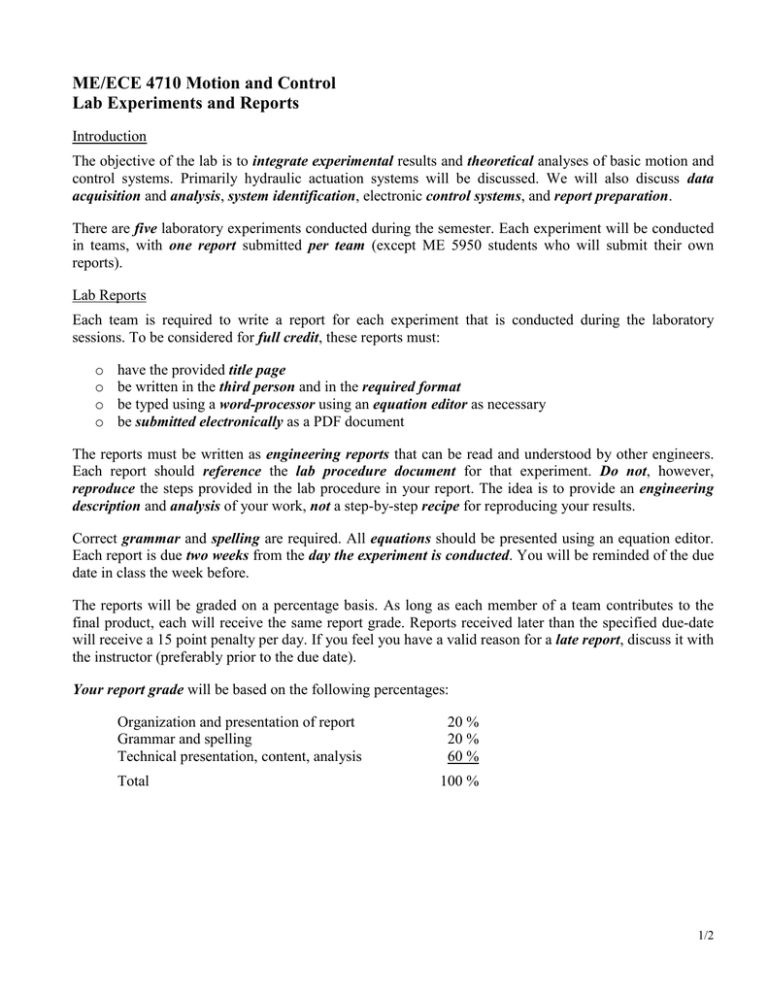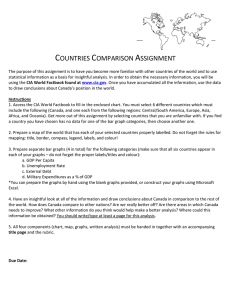ME/ECE 4710 Motion and Control Lab Experiments and Reports
advertisement

ME/ECE 4710 Motion and Control Lab Experiments and Reports Introduction The objective of the lab is to integrate experimental results and theoretical analyses of basic motion and control systems. Primarily hydraulic actuation systems will be discussed. We will also discuss data acquisition and analysis, system identification, electronic control systems, and report preparation. There are five laboratory experiments conducted during the semester. Each experiment will be conducted in teams, with one report submitted per team (except ME 5950 students who will submit their own reports). Lab Reports Each team is required to write a report for each experiment that is conducted during the laboratory sessions. To be considered for full credit, these reports must: o o o o have the provided title page be written in the third person and in the required format be typed using a word-processor using an equation editor as necessary be submitted electronically as a PDF document The reports must be written as engineering reports that can be read and understood by other engineers. Each report should reference the lab procedure document for that experiment. Do not, however, reproduce the steps provided in the lab procedure in your report. The idea is to provide an engineering description and analysis of your work, not a step-by-step recipe for reproducing your results. Correct grammar and spelling are required. All equations should be presented using an equation editor. Each report is due two weeks from the day the experiment is conducted. You will be reminded of the due date in class the week before. The reports will be graded on a percentage basis. As long as each member of a team contributes to the final product, each will receive the same report grade. Reports received later than the specified due-date will receive a 15 point penalty per day. If you feel you have a valid reason for a late report, discuss it with the instructor (preferably prior to the due date). Your report grade will be based on the following percentages: Organization and presentation of report Grammar and spelling Technical presentation, content, analysis Total 20 % 20 % 60 % 100 % 1/2 Required Format of Lab Reports All lab reports must be double-spaced and have the following five sections: 1. 2. 3. 4. 5. Abstract Introduction Experimental Procedures Experimental Results Analysis and Conclusions. They must also have a title page using the correct format (a Word document file is on the course web site for your use). Organization, clarity, and completeness of the report are very important. Abstract (should be short and concise) o State concisely and completely: o Major objectives o Major conclusions Introduction (should generally be longer than the Abstract) o Description of the subject background and of the scope of the experiment. o Describe elements of theoretical background related to the experiment. Use reference books and the web for background material. Remember, however, that reports must be your own work. Do not copy and paste information from other sources! o What is the purpose of this experiment? Experimental Procedures o Description of the test set-up and the equipment used as they pertain to your experiment. Simple figures are always helpful. Each figure must be referred to explicitly in the text. You are welcome to use any figures you find on the course web site. o Description of the testing procedure. Focus on the big picture. Describe the procedures as they apply to your experiment. Reference the step-by-step procedure provided by the instructor as necessary, but do not repeat it. Results o Provide a written summary of the data you collected. Include tables and graphs as necessary. All tables and graphs should be referenced explicitly in the text. o Graphs must be computer generated with self-explanatory labeling. All graphs must have titles. Axes must be labeled with units and scales. Presentation is important. o Include only the data you measured, NOT data derived from your measurements. Save derived data for the analysis-conclusions section. Analysis and Conclusions o Analyze and interpret your data. Provide conclusions of the experiment. What did you learn? Present any analyses required to support your conclusions. o Present and explain any formulas used in the data analysis (you don’t need to explain units conversions). o Discuss and justify possible error sources. o Discuss limitations of the equipment and methods used. 2/2



